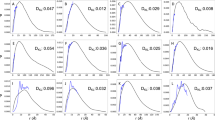Abstract
This paper investigates the problem of supervisedly classifying proteins according to their structural similarity, based on the information enclosed within their conformational transitions. We are proposing AutoSimP approach consisting of an ensemble of autoencoders for predicting the similarity class of a certain protein, considering the similarity predicted for its conformational transitions. Experiments performed on real protein data reveal the effectiveness of our proposal compared with similar existing approaches.
Access this chapter
Tax calculation will be finalised at checkout
Purchases are for personal use only
Similar content being viewed by others
References
The UniProt Consortium: The universal protein resource (UniProt). Nucleic Acids Res. 35(Database-Issue), 193–197 (2007). https://doi.org/10.1093/nar/gkl929
Albert, S., Teletin, M., Czibula, G.: Analysing protein data using unsupervised learning techniques. Int. J. Innov. Comput. Inf. Control 14, 861–880 (2018)
Ambrogelly, A., Palioura, S., Soll, D.: Natural expansion of the genetic code. Nat. Chem. Biol. 3, 29–35 (2007)
Clevert, D.A., Unterthiner, T., Hochreiter, S.: Fast and accurate deep network learning by exponential linear units (elus). arXiv preprint arXiv:1511.07289 (2015)
Dayhoff, M.O., Schwartz, R.M.: A model of evolutionary change in proteins (Chap. 22). In: Atlas of Protein Sequence and Structure (1978)
Gal, Y., Ghahramani, Z.: A theoretically grounded application of dropout in recurrent neural networks. In: Advances in Neural Information Processing Systems, pp. 1019–1027 (2016)
Goodfellow, I., Bengio, Y., Courville, A.: Deep Learning. MIT Press, Cambridge (2016)
Gu, Q., Zhu, L., Cai, Z.: Evaluation measures of the classification performance of imbalanced data sets. In: Cai, Z., Li, Z., Kang, Z., Liu, Y. (eds.) ISICA 2009. CCIS, vol. 51, pp. 461–471. Springer, Heidelberg (2009). https://doi.org/10.1007/978-3-642-04962-0_53
Hubbard, T.J.P., Ailey, B., Brenner, S.E., Murzin, A.G., Chothia, C.: SCOP: a structural classification of proteins database. Nucleic Acids Res. 27(1), 254–256 (1999)
Jo, T., Hou, J., Eickholt, J., Cheng, J.: Improving protein fold recognition by deep learning networks. Sci. Rep. 5, 17573 (2015)
Lesk, A.: Introduction to Protein Science. Oxford University Press, Oxford (2004)
Mansoori, E.G., Zolghadri, M.J., Katebi, S.D.: Protein superfamily classification using fuzzy rule-based classifier. IEEE Trans. NanoBiosci. 8(1), 92–99 (2009)
Meyer, T., et al.: MoDEL: a database of atomistic molecular dynamics trajectories. Structure 18(11), 1399–1409 (2010)
Pandini, A., Fornili, A., Kleinjung, J.: Structural alphabets derived from attractors in conformational space. BMC Bioinform. 11(97), 1–18 (2010)
Wei, L., Zou, Q.: Recent progress in machine learning-based methods for protein fold recognition. Int. J. Mol. Sci. 17(12), 2118 (2016). PMID: 27999256
Acknowledgments
The authors thank lecturer Alessandro Pandini from Brunel University, London for providing the protein data sets used in the experiments.
Author information
Authors and Affiliations
Corresponding author
Editor information
Editors and Affiliations
Rights and permissions
Copyright information
© 2019 Springer Nature Switzerland AG
About this paper
Cite this paper
Teletin, M., Czibula, G., Codre, C. (2019). AutoSimP: An Approach for Predicting Proteins’ Structural Similarities Using an Ensemble of Deep Autoencoders. In: Douligeris, C., Karagiannis, D., Apostolou, D. (eds) Knowledge Science, Engineering and Management. KSEM 2019. Lecture Notes in Computer Science(), vol 11776. Springer, Cham. https://doi.org/10.1007/978-3-030-29563-9_5
Download citation
DOI: https://doi.org/10.1007/978-3-030-29563-9_5
Published:
Publisher Name: Springer, Cham
Print ISBN: 978-3-030-29562-2
Online ISBN: 978-3-030-29563-9
eBook Packages: Computer ScienceComputer Science (R0)




